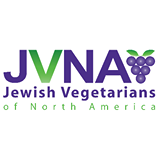By Richard H. Schwartz
As president emeritus of Jewish Vegetarians of North America, I would like to address the many recent efforts in several countries to ban shechita (Jewish ritual slaughter).
First, although JVNA believes that every person should be a vegan and that there should be NO slaughter of animals at all, we also oppose efforts to single out shechita for special criticism. There are many factors in the shechita process designed to minimize pain. Animals are to be killed by a shochet (ritual slaughterer), a religious Jew who is especially trained and certified. He ideally kills the animal with a single stroke, using a very sharp knife that is inspected frequently to make sure there are no imperfections.
Unfortunately, as in non-kosher slaughterhouses, shechita is not always carried out perfectly under current mass production conditions. The horrible treatment of animals several years ago at the largest kosher slaughterhouse in Postville, Iowa, revealed by undercover videos, is one example. However, such violations should be addressed though better regulations and more diligent inspection, rather than by banning shechita.
Those who argue that shechita should be banned are ignoring the many problems related to stunning, their preferred approach to slaughter. These are thoroughly covered in the book, Slaughterhouse: The Shocking Story of Greed, Neglect, and Inhumane Treatment Inside the U.S. Meat Industry, by Gail Eisnitz. Through many interviews with slaughterhouse workers and USDA inspectors, she carefully documents in gut wrenching, chilling detail the widespread, unspeakable torture and death at U.S. slaughterhouses where animals are stunned prior to slaughter.
The book discusses cases where animals are dismembered while still alive when the stunning is not properly performed, which frequently happened under the frenzied slaughterhouse conditions . Here is the testimony of one worker, on cow slaughter: “A lot of times the skinner finds a cow is still conscious when he slices the side of its head and it starts kicking wildly. If that happens, … the skinner shoves a knife into the back of its head to cut the spinal cord.” (This paralyzes the animal, but doesn’t stop the pain of being skinned alive.)
And of another worker, on calf slaughter: “To get done with them faster, we’d put eight or nine of them in the knocking box at a time… You start shooting [with the stunning gun], the calves are jumping, they’re all piling up on top of each other. You don’t know which ones got shot and which didn’t… They’re hung anyway, and down the line they go, wriggling and yelling” (to be slaughtered while fully conscious).
Many workers admit to becoming sadistic and cruel under the horrible conditions of their daily efforts.
Eisnitz’s closing comment, “Now you know, and you can help end these atrocities,” is still applicable today. While her research involved only U.S. slaughterhouses, it is likely in today’s highly competitive markets that conditions in other country’s slaughterhouses are not very different.
While concern for animal welfare during the final minutes prior to slaughter is commendable, efforts to ban shechita ignore the many abuses that occur for months on factory farms. Just a few examples: (1) Male chicks at egg-laying hatcheries are killed almost immediately after birth, since they can’t lay eggs and have not been genetically programmed to produce much flesh. (2) Dairy cows are artificially impregnated annually on what the dairy industry calls “rape racks,” so that they will be able to continue ‘giving’ milk, and (3) their babies are taken away almost immediately, often to be raised as veal under very cruel conditions.
If governments really want to improve conditions for as many animals as possible, as they should, they should take steps to reduce the consumption of meat and other animal products. Besides reducing the number of animals suffering on factory farms, this would have additional benefits:
* There would be a reduction in the widespread heart disease, several types of cancer, and other diseases afflicting so many people.
* There would be a reduction in the emission of greenhouse gases. While the world is increasingly threatened by climate change, a 2006 UN Food and Agriculture Organization report, “Livestock’s Long Shadow,” indicated that animal-based agriculture emits more greenhouse gases (in CO2 equivalents) than is emitted by the cars and all other means of transportation worldwide combined.
* There would be a reduction in environmental problems, including deforestation, soil erosion, water pollution, loss of biological diversity, and desertification.
* Resources would be used more efficiently. In an increasingly thirsty and energy-dependent world, a person on an animal-based diet requires up to 14 times as much water (mainly for irrigating feed crops) and 10 times as much energy as a person on a vegan (only plants) diet.
* There would potentially be a reduction in the number of hungry people. At a time when food prices are skyrocketing, an estimated 20 million people are dying annually worldwide from hunger and its effects, and almost a billion of the world’s people are chronically hungry, 70 percent of the grain produced in the United States and 40 percent produced worldwide are fed to farmed animal. What makes that even more shameful is that the corn, soy, and oats that are high in fiber and complex carbohydrates are converted into animal products that are devoid of these nutrients, but high in cholesterol and saturated fat that are very harmful to health.
So, rather than focusing on banning shechitah, governments have the opportunity to do far more that not only would be very beneficial to defenseless animals, but would also help produce a healthier, environmentally sustainable world.



















